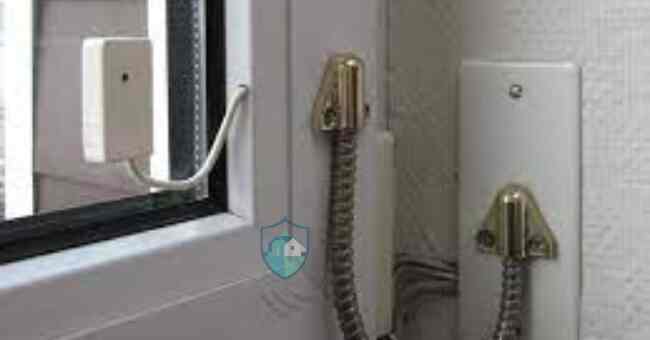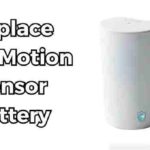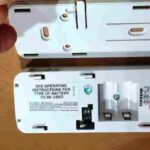Table of Contents
How to test a glass break sensor properly? Testing a glass break sensor is crucial for ensuring your home’s security system can effectively detect the sound of an intruder breaking in through a window or glass door.
I learned this lesson the hard way years ago when faulty sensors failed to trigger the alarm during a break-in at my childhood home.
The experience shook our sense of safety. After that incident, I became committed to testing our sensors thoroughly and keeping them in peak condition.
In this guide, I will explain in detail how to choose the right location to install glass break sensors, which specialized equipment you need, techniques for re-creating glass shattering sounds, and steps for adjusting settings to avoid false alarms.
Follow along to learn how to test your glass break sensors for maximum home protection.
Here we go.
What Is A Glass Break Sensor?
A glass break sensor, also called a glass break detector, is a special type of acoustic detector designed to pick up the unique frequencies produced when glass breaks.
By recognizing the sound profile of shattering glass, glass break sensors can instantly trigger an alarm in your security system if an intruder smashes a window or glass door to gain entry.
Regularly testing your glass break sensors is important for two main reasons:
- Ensuring accurate detection – You want to verify that your sensors will reliably detect the sound of breaking glass and activate the alarm. Testing helps confirm they are functioning properly.
- Preventing false alarms – Proper testing enables you to adjust sensitivities and settings to avoid false alarms from ambient noises like barking dogs, loud music, construction sounds, etc.
While the process isn’t overly complicated, there are some best practices to follow for testing glass break sensors effectively.
This guide will cover:
- How to choose the right location to install glass break sensors
- Equipment you’ll need to conduct sensor tests
- Techniques for creating different glass break sounds
- Steps to test sensor detection and adjust sensitivities
- Tips for troubleshooting any sensor issues
- Maintenance recommendations to keep sensors in peak condition
So let’s get started and make sure your home’s glass break detection system is working like a charm.
Choosing the Right Location
The first step in testing your glass break sensors is making sure they are positioned appropriately to monitor the windows and glass doors you want to protect.
Positioning for Optimal Coverage
- Glass Break Sensor
- Install glass break sensors 6 to 10 feet away from the protected glass. This allows the sensor to best “hear” the full range of breaking glass frequencies.
- Glass Break Detector
- Position glass break detectors with a clear line-of-sight to the glass being monitored. Obstructions can dampen or distort the sound profile.
- Acoustic Glass Break Sensor
- For large areas of glass, use multiple acoustic glass break sensors to eliminate blind spots in coverage.
- Glass Break Frequency
- Make sure the sensor’s frequency range matches the natural resonance frequencies of the type of glass installed.
Avoiding False Alarm Triggers
- False glass break alarm
- Keep glass break sensors away from noise sources like speakers, televisions, appliances, high traffic areas, etc. This helps avoid false alarm triggers.
- Glass break frequency range
- Adjust detection frequency range to minimize activation from ambient background sounds. Narrow bands focusing on glass resonance work best.
- Check glass break coverage
- Test sensors with loud music, slamming doors, barking dogs etc. If they alarm, adjust location or settings until noise resistant.
Number of Sensors Needed for Complete Protection
- Glass break sensor:- For full coverage across large rooms, multiple glass break sensors are recommended, positioned at 15-20 foot intervals.
- Glass break detection range:- Each glass break sensor monitors approximately 15-25 feet surrounding its location. Use enough to cover entire glass area.
- Glass break sensor range:- Check the detection range specs before installing (usually 15-25 ft). Account for room layout obstructions.
With your glass break sensors optimally placed, you’re ready to gather what you’ll need for the testing process.
Equipment You’ll Need on How To Test A Glass Break Sensor
Conducting thorough tests of your glass break sensors will require a few specialized pieces of equipment. Here are some must-haves:
- Sound Frequency Tester:- A sound frequency meter allows you to analyze the frequency profile of glass break sounds during testing.
- Glass Break Simulator:- Specialized tools like the Sentrol 5709 Glass Break Simulator can replicate the sound frequencies of shattering glass for sensor testing.
- Audio Recording Device:- A microphone, phone, or other recorder can capture sample glass break sounds for testing purposes.
- Safety Gear:- For safety, use thick gloves when handling glass and goggles to protect eyes from debris.
While not mandatory, having a few other handy items can also help make your testing process easier:
- Spare glass pieces or broken tempered glass simulator film
- Variable volume stereo or speaker system
- Ladder or lift for reaching high-mounted sensors
- Manufacturer’s sensor testing documentation
Okay, with the right tools in hand and safety first, you’re ready to start making some glass breaking noises.
Testing Different Glass Types
To test glass break sensors thoroughly, it’s helpful to recreate the sound frequencies produced by various glass types and thicknesses.
Here’s a quick primer on matching glass break audio to glass characteristics:
Annealed Glass
Annealed glass is standard float glass. When broken, it cracks into large shards with lower frequency noises.
Tempered Glass
Tempered glass is treated with heat for strength. It shatters into small cube-like pieces producing distinct higher frequencies.
Laminated Glass
- Laminated glass has a plastic layer holding shards together. Frequency profile combines cracking and tearing sounds.
- Use a frequency meter to analyze noises from sample glass types. Match simulated sounds to real glass frequency profiles.
- Vary decibel levels during testing – thicker glass requires more force so produces louder breaks.
Now that you understand the different sound characteristics, let’s go over some techniques for recreating them.
Conducting Your Audio Test
To test the sound detection capabilities of your glass break sensors, you’ll want to produce a range of glass breaking noises. Here are some options:
Using Pre-Recorded Sounds
- Glass break sounds:- Obtain or create high-quality recordings of different glass breaks. Playback at varied volumes to test sensor.
- Glass break test sounds:- Use a glass break simulator tool with built-in sound effects that mimic real glass shattering audio.
Generating Tapping and Knocking Noises
- Knocking or tapping on glass panes creates lower frequency resonances. Vary force for different decibel levels.
- Dropping objects from low heights onto glass produces subtle cracking noises to test sensitivity.
Varying Decibel Levels and Distances
- Glass break decibels:- Test sensors with both low volume breaks (like distant window) and loud immediate breaks.
- Glass break sensor distance:- Conduct audio tests from multiple distances – up close and far back from the sensor.
- Glass break detection range:- Confirm detection from manufacturer’s stated range (usually 15-25 feet).
Get creative with making sounds that mimic glass breaking across the frequency spectrum at different volumes to thoroughly test detection capabilities!
Checking Sensor Sensitivity
In addition to testing whether your glass break sensors recognize glass shatter noises, you also need to check that sensitivity settings are configured properly:
Adjusting Settings for Detection Range
Adjust sensitivity and range settings so ambient background noise doesn’t trigger alarm, but loud glass break sounds from 15-25 feet away do activate it. Try dropping sensitivity if sensor alarms from ambient noises. Increase if loud breaks nearby don’t trigger.
Preventing False Alarms from Ambient Noise
- If loud background sounds are causing false alarms, decrease sensitivity and use narrower frequency bands targeting glass resonance.
- Glass break frequency range:- Widen or narrow frequency range to isolate glass break sound profile from ambient noises.
Tuning for Different Room Acoustics
- Glass break audio can reflect off hard surfaces. Adjust sensitivity higher in rooms with more acoustics damping.
Sensitivity tuning during testing ensures your glass break sensors detect actual intrusion attempts reliably while ignoring common false alarm triggers.
Troubleshooting Tips
During your sensor testing, issues like failed detection or false alarms may occur.
Here are some troubleshooting tips for common glass break sensor problems:
No Alarm When Glass Break Occurs
- Glass break microphone:- Check for physical damage, debris, or muffling of the sound input microphone.
- Low glass break sensor battery :- Replace low batteries immediately to maintain proper performance.
- Glass break calibration:- Sensors may need calibration if they fail to detect glass breaks during testing.
Sensor Battery or Wiring Issues
- Check glass break sensor wiring:- Inspect wiring connections for damage or looseness.
- Test glass break sensor battery:- Battery issues are common. Test and replace dead batteries right away.
Interference from Other Electronics
Wireless electronics, motors, and cameras can cause signal interference. Relocate/isolate sensor. If problems persist after troubleshooting, contact the manufacturer for additional support.
Maintaining Peak Performance
To keep your glass break sensors working their best for home security, perform regular maintenance:
Regular Re-Calibration
- Re-calibrate sensors at least once per year to adjust for environmental changes and drift.
Sensor Replacement Schedule
- Plan on replacing sensors every 5-8 years as sound detection technology improves.
Updating Firmware and Features
- Download firmware updates for enhanced performance and new glass break audio algorithms. Add glass break sensor app connectivity, consider app connectivity upgrades to view sensor status and receive mobile alerts.
With periodic maintenance factored into your home security strategy, you can rely on your glass break sensors to deliver reliable, long-term protection.
FAQs
How Do Glass Break Sensors Work?
Glass break sensors are acoustic detectors that listen for the unique sound frequency produced when glass breaks. They use a microphone to pick up audio and analyze the frequency pattern to match the profile of shattering glass. If a match is detected, the alarm is triggered. Advanced digital signal processing filters out ambient background noises to avoid false alarms.
How Do You Test The Glass Break Sensor On Simplisafe?
To test SimpliSafe’s glass break sensor, you can use the app’s sensor testing mode. This plays an audio tone and checks that the sensor detects it. You can also tap lightly on glass with a metal object to simulate breakage sounds.
Check that the sensor LED blinks and the app indicates an alarm. Adjust sensitivity in the app if needed.
What Causes A Glass Break Sensor To Go Off?
A glass break sensor can be triggered by noises that match the acoustic frequency profile of breaking glass, like actual broken windows or glass doors.
Loud shattering glass sounds within 15-25 feet are the prime triggers. False alarms can occur from hammering, glass tapping, barking dogs, music bass, appliance vibrations etc. Proper installation and settings adjustment helps avoid false alarms.
Do Glass Break Sensors Need Batteries?
Yes, most glass break sensors are powered by small onboard batteries similar to 9V alkaline batteries. They provide 1-2 years of operation before needing replacement. Some newer sensors have 10 year non-replaceable lithium batteries.
The sensor will indicate low battery status through blinking LED lights and/or app notifications when replacement is needed.
Do Glass Break Sensors Go Bad?
Like any electronic device, glass break sensors can deteriorate over time. The microphone and sound detection accuracy may degrade after 5-8 years. Environmental factors like temperature extremes can impact performance.
Signs of a failing sensor include reduced detection range, failure to trigger on glass breaks, false alarms, and battery issues. Replacing sensors every 5-8 years ensures peak performance.
What Is The Range Of A Glass Break Sensor?
Quality glass break sensors can detect the sound of shattering glass reliably from 15-25 feet away. This allows a single sensor to cover a 15-20 foot radius, protecting multiple nearby windows.
Detection range can vary based on type of glass, room acoustics, obstructions, and sensor mounting location. Refer to the manufacturer’s specs for the optimal performance range.
Why Is My Glass Break Sensor Blinking Red?
A blinking red light on a glass break sensor usually indicates a low battery alert. The battery is nearing complete depletion and should be replaced immediately to maintain protection.
Refer to the manufacturer’s instructions on battery replacement. Some systems may also blink red to indicate a trouble condition like lost wireless signal or calibration issue.
Why Is My Glass Break Sensor Beeping?
Intermittent beeping from a glass break sensor is typically caused by connectivity or calibration problems. Beeping may indicate the sensor is not communicating properly with the control panel due to distance, interference, or obstructions.
Some systems beep after a certain period of inactivity to remind users to test the sensor. Refer to troubleshooting steps in the product manual.
How Do You Pair A Glass Break Sensor?
To pair a new glass break sensor, refer to the instructions for your security system brand. Usually there is an enrollment button on the sensor that must be pressed to put it in pairing mode.
Then a command is entered on the control panel, mobile app, or keypad to search for and connect the new sensor. The system will indicate successful pairing and allow you to name and install the sensor. Do a test to confirm proper alarm triggering.
Conclusion
Testing glass break sensors is essential for maintaining your home’s security. Always remember to install them in optimal locations with clear coverage of windows and doors but avoid false alarms from ambient noises; troubleshoot any sensor malfunctions immediately; and perform annual maintenance like re-calibration, battery changes, and firmware updates.
Following this comprehensive testing and maintenance guide will ensure your glass break sensors are always performing at their peak to detect intrusions early and reliably trigger the alarm.
Test your sensors regularly to keep your home and family protected against the threat of break-ins.




